|

I've been barbecuing Prime Rib for Christmas
for a long time. This page highlights a few things I've learned over the years.
Ingredients:
- 17 pound (or so) Whole Bone In Prime Rib (will feed at least 8 and up to 17
people). Re-heating leftovers is not a problem.
- 6 cloves garlic - cut each clove into 4 pieces
- 6 sprigs of fresh Rosemary
- Drip pan to put under the grate and the meat
- Turkey bag to hold the seasoned meat overnight in the refrigerator
- Maple, fruit, and/or oak wood chips
- Horseradish
- Olive oil
- Rub:
- 2 tablespoons
black peppercorns
- 4 tablespoons dried rosemary
- 4 tablespoons coarse (kosher, sea, pickling) salt
- 4 tablespoons sweet paprika
- 4 tablespoons brown sugar
General:
- These instruction are for cooking the Prime Rim to Medium Rare - you can
adjust as necessary
- The local grocery stores seem to always have Prime Rib on sale around
Christmas time, so it's a good time to buy it
- The store may call the meat Prime Rib, Rib Eye Roast, Whole, Large End,
or Small End. Always get Bone In
- Small End is supposed to be more tender then the Large End. Whole
has both Large and Small End
- I get Prime Rib that's labeled USDA Choice
- If you need more than 10 pounds you'll get Whole. I usually purchase
12-21 pounds
- On average adults seem to eat about an equivalent of a little more
than a pound (5 adults will eat about 1/2 of an 11 pound roast)
- There's more on re-heating leftovers below
- Also, if your roast is really too big you can cut a chunk off and
wrap and freeze it for another occasion
- I cook the Prime Rib cut and tied with no fat removed
- The ribs are cut off and then tied back to the meat
- The cut ribs makes serving a lot easier, the ribs tied back help
when barbecuing, the fat helps when barbecuing (plus it tastes good)
- You can have the butcher cut and tie it:
- They may charge for this service - ask
- Ask them to not trim off the fat
- It may come in a bag - ask them to cut and tie it just before
you pick it up
- You can do it yourself:
- It should come sealed in a bag (which keeps it fresh longer)
- You should unseal it and cut and tie it just before cooking
- You can get the rub in-between the ribs and the meat before you
tie it
- If you're going to cook on Christmas then order pickup for Christmas Eve
or the day before
- On Christmas Eve:
- Make the rub (crush and combine all ingredients
- Unpack the meat
- If necessary cut off a chunk of the roast, wrap it, and put it in
the freezer for another day
- If not already done cut off the ribs
- Rinse meat with water, don't dry off the water, and spread the rub all over the
meat and ribs (the water will melt the rub better than oil)
- If not tied then tie the ribs to the meat
- Put the meat in a turkey bag and put it in the refrigerator for
tomorrow
- Clean the grill, crank up the heat to burn off the grates, turn off, when
everything is cool put a drip pan under the middle grate(s)
- Plan to cook the Prime Rib for 40 minutes per pound, and don't plan a
rest - carve and serve immediately.
- On Christmas:
- Put wood chips on the grate over the side burners and heat the
grill using the side burners (leave the center burner(s) off
- Before cooking:
- Take the meat out of the bag
- Cut slits in the top every few inches and insert the garlic
pieces
- Add rosemary sprigs under strings
Photographs and the Process
If you're going to cut and tie it
yourself then pick up your bagged prime rim on Christmas Eve.
This one is just the right size for our celebration:
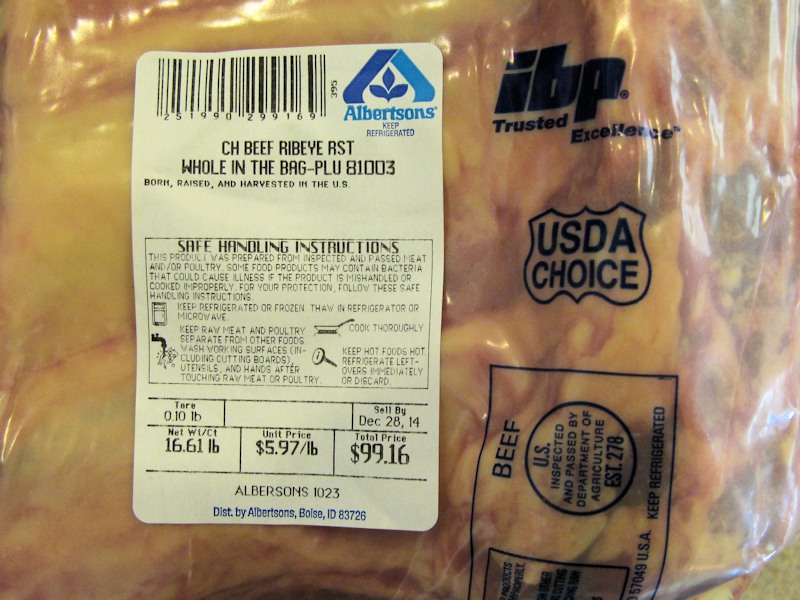
This one was too big, because it
was a great price!
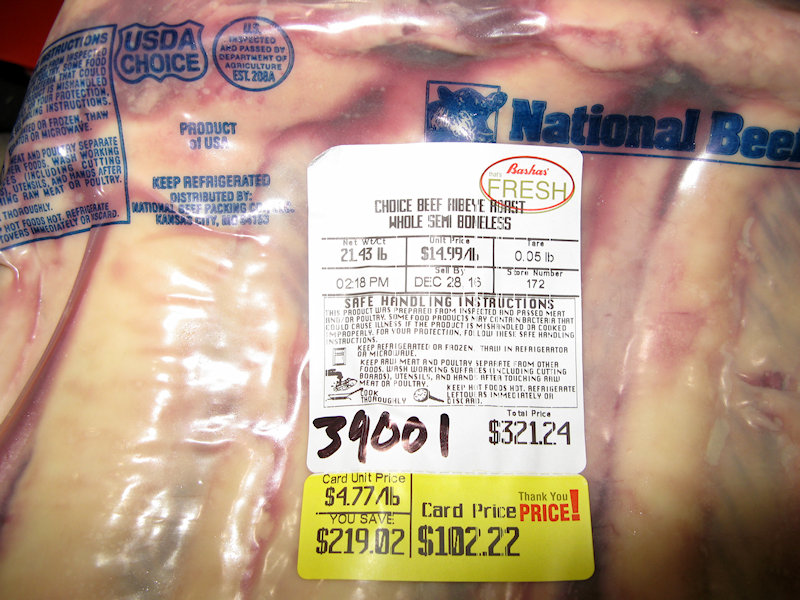
So, a chunk was cut off and frozen
for a later meal:
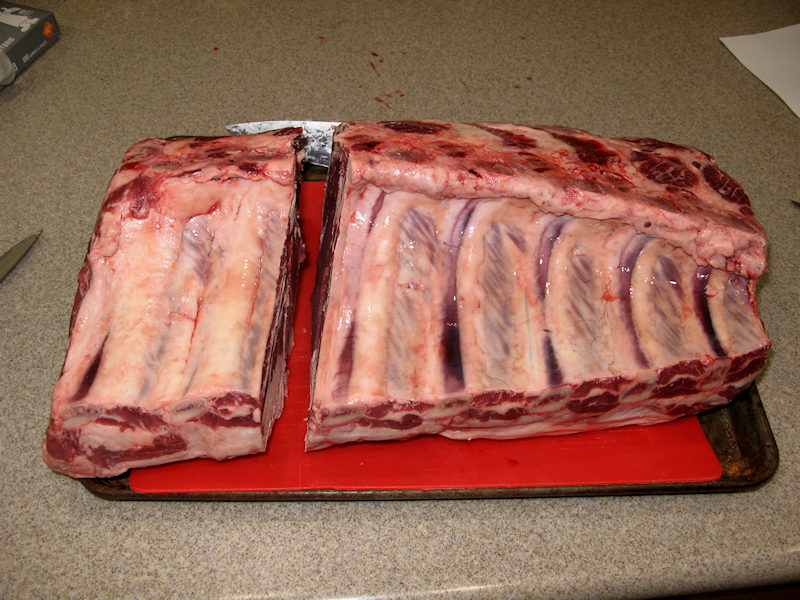
Remove the
prime rib from the bag. If you plan to cut and tie it yourself
then you'll want to use
a sharp knife and slowly start cutting down from the
edge of the ribs to the backbone:
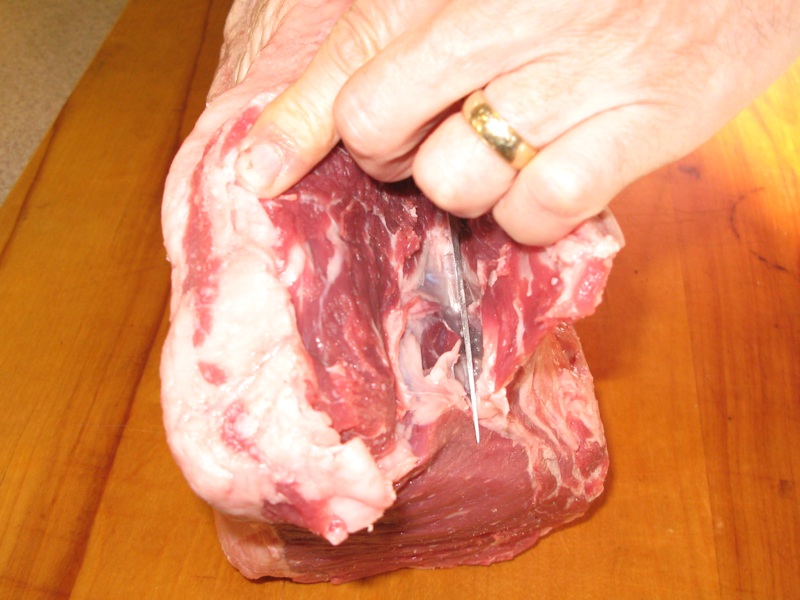
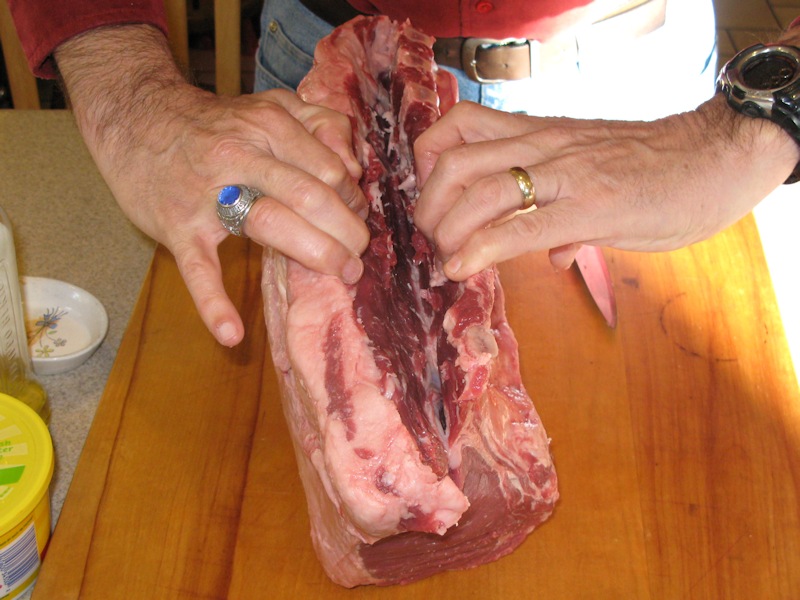
As you're cutting, pull the meat
away from the bones and continue to cut trying to leave as little meat on the
ribs as possible:
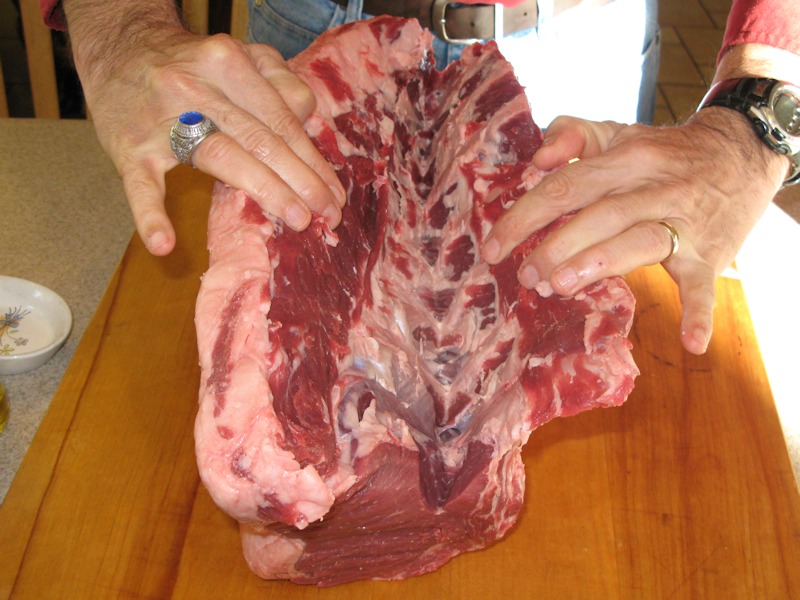
Almost to the backbone:
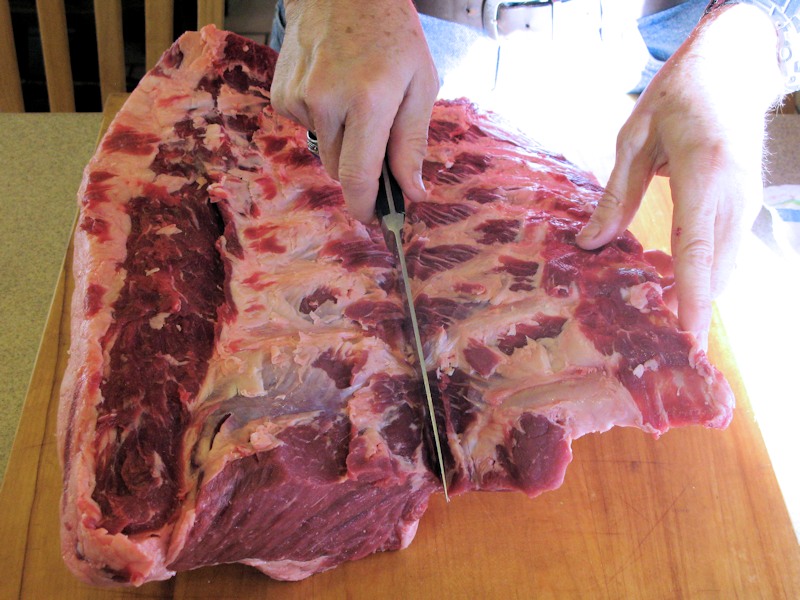
Ribs removed:
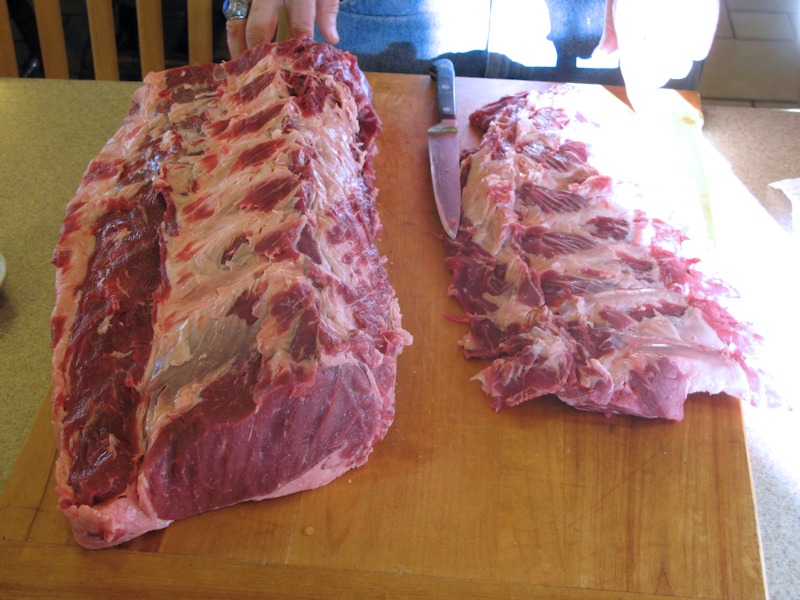
Now you want to prepare the ribs,
remove the connective tissue from the outside:
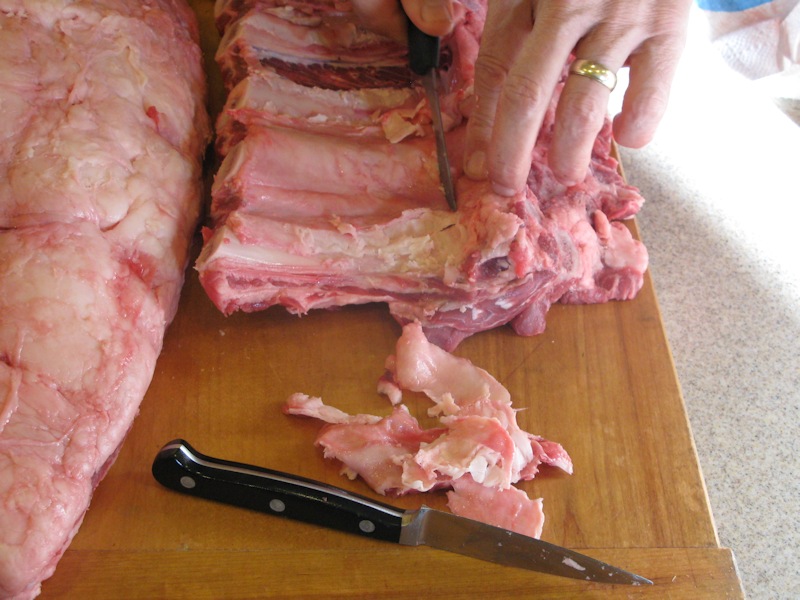
You'll want to scrape all of it off
the meat because if you try to eat it you'll find out it's like chewing a rubber band:

Next you'll want to remove the
buttons. You can slice up to them but you'll need to use the point
of the knife
to get between them and the ribs:
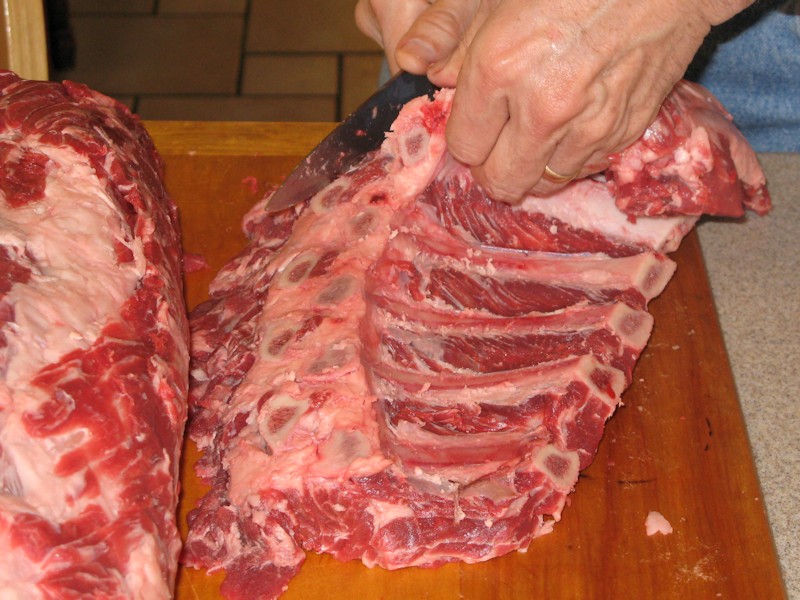
All cut and ready for the next
step:
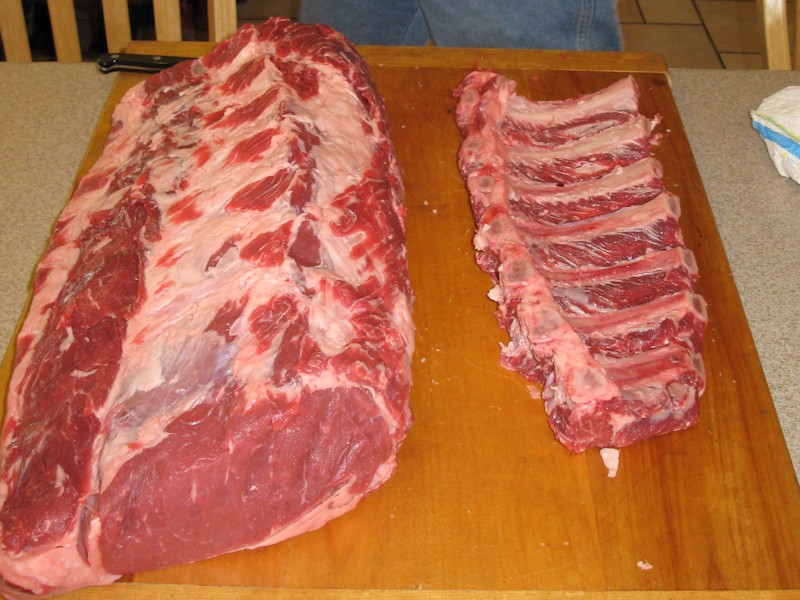
Note that you may want to put all
of the scraps into a stock pot:
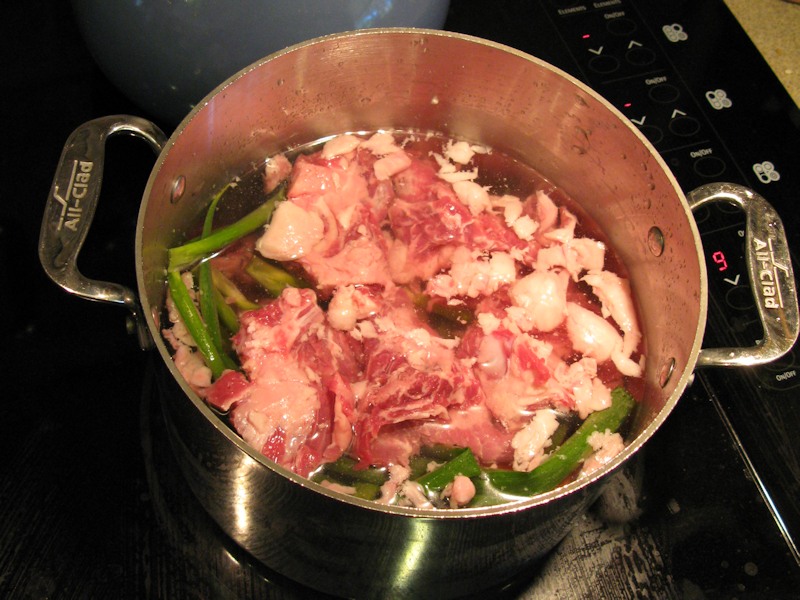
Apply the
oil and seasoning to the meat and ribs:
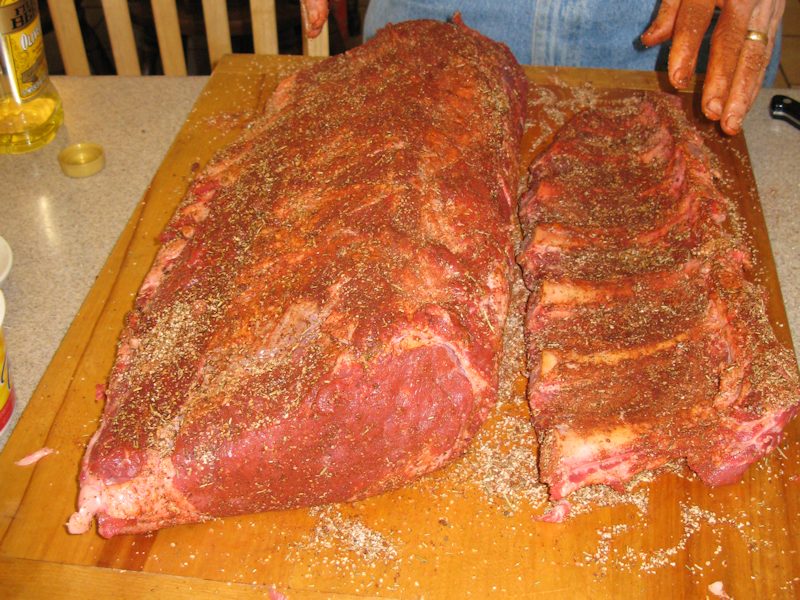
Put the meat back on top of the
ribs:
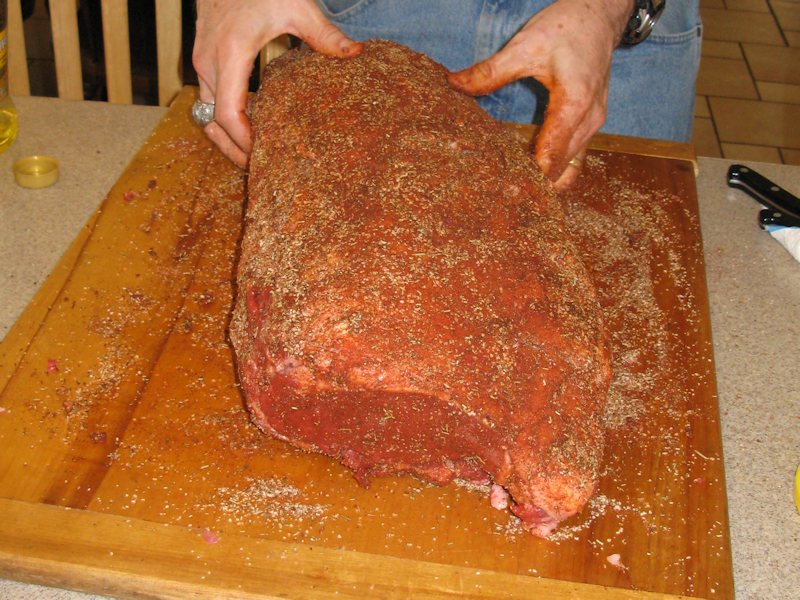
Tie everything together with
cooking twine (cotton) about 2" apart using a
surgeons knot - 3 loops on the bottom, 1 on the top - make it snug, then put it
in a turkey bag and the refrigerator:
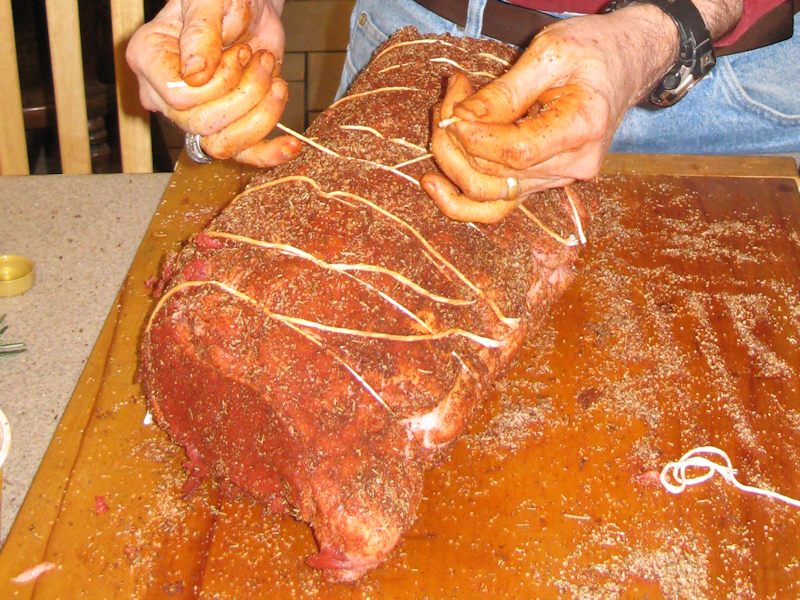
The next day, make slits and insert the garlic:
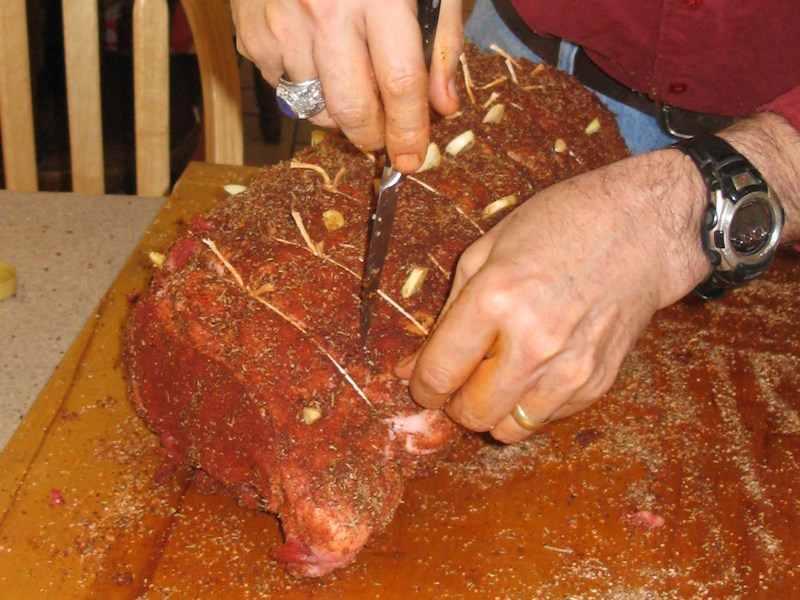
Insert the rosemary under the string, ready for the grill.
Note: you don't want to let your prime
rib sit out and "warm up" before putting it on the grill. The colder meat
actually attracts smoke
so when you are finished the final prep then put it directly in your grill.
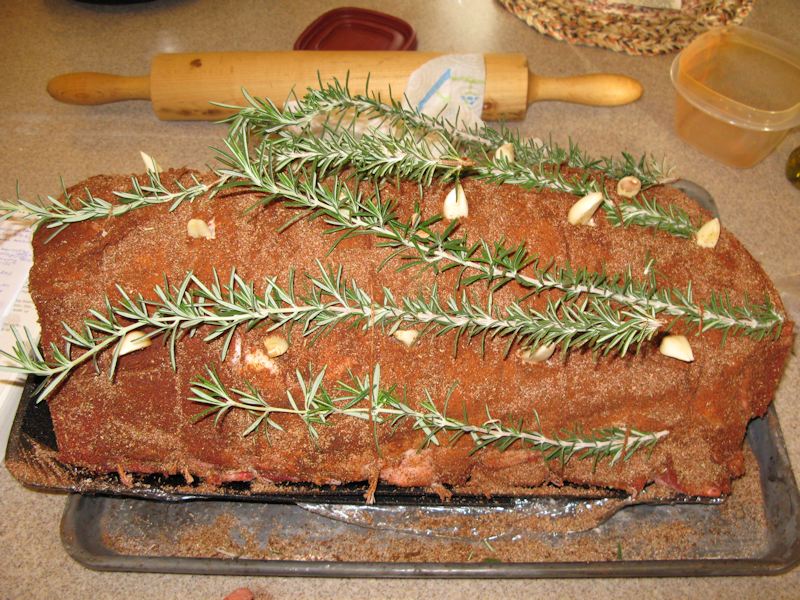
Before placing the meat in the
grill rub some olive oil on the grate. You should have a good accurate
thermometer to measure the temperature of the grill and at least two
thermometers
(one mechanical and 1 electronic) to measure the temperature of the
meat (temperature of the meat
is important and I've found that sometimes just
one thermometer isn't a good idea):
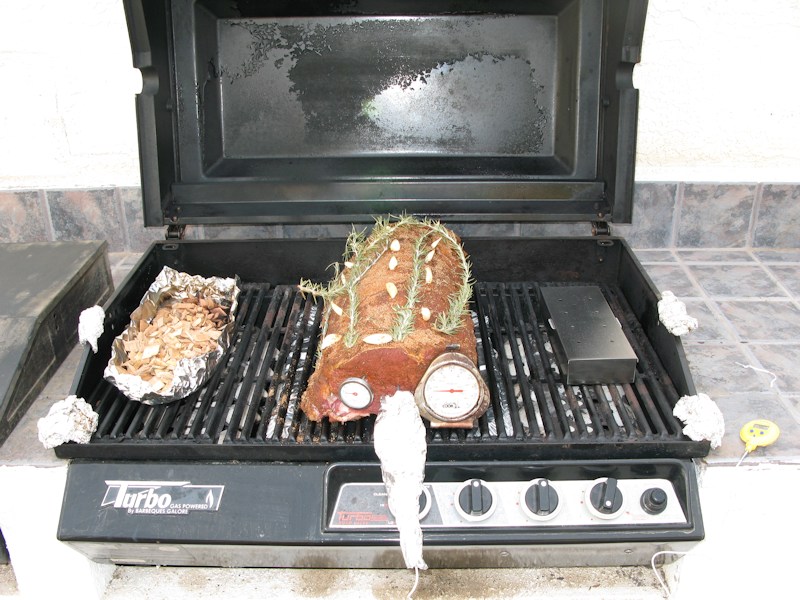
With the lid closed keep the
barbeque temperature between 180 - 190° F (below 200° F). Record the
temperature
of the meat every 30 minutes and you'll get a good idea of the progress. Replace
wood chips
as necessary. At 128° F you may want to crank the side burners to the max to help make a crust and
make
the edge of the Prime Rib closer to medium. When the meat reaches 130° F it's
done. All cooked:
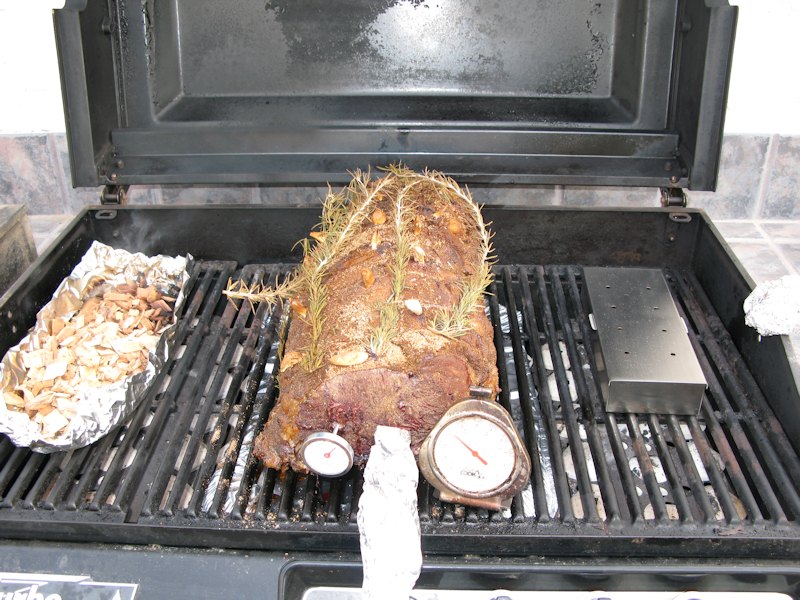
No rest is needed or wanted. A
rest doesn't create extra juices, but it does soften your nice crust,
and with a rest you'll have to monitor/wait for the carryover temperature to be
correct.
Without the rest, by the time you are set to carve the meat it will probably
already have
increased to 131° F (which is fine). Cut the string that holds
the ribs, and put the meat in a
shallow pan with a cutting
pad under it (to capture the juices).
Note: keep your notes and use them next
year to help tweak your process. Make that first cut...
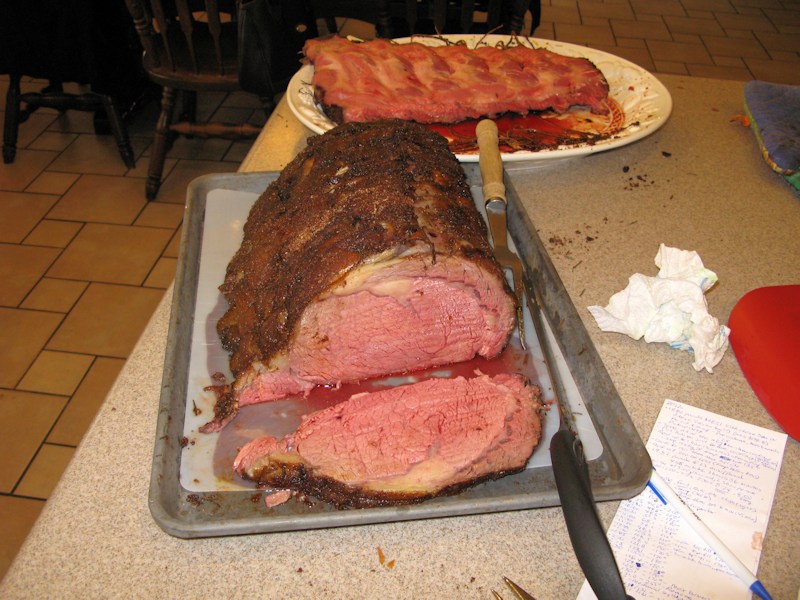
Yum:
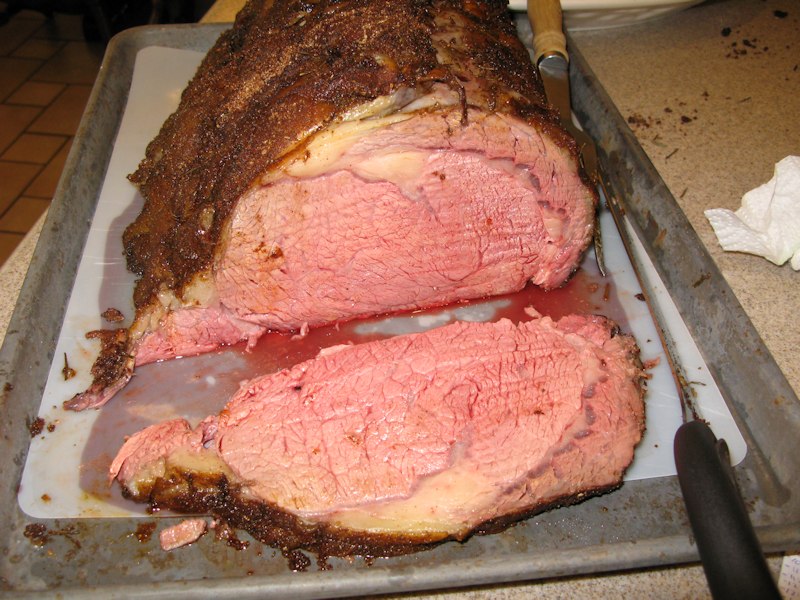
When your Christmas meal is over
save the uncut piece of meat in the refrigerator. You can make
leftovers and
still have nice red meat to eat. When it's time for leftovers slice off the meat
you want,
put each slice in a zip lock bag, put the bags in the sink in hot
water (120° F). You can drain/add water
from the tap (if it's hot enough),
and/or mix in boiling water to keep the temperature up.
After 45 minutes to 1
hour your meat will be warm (not hot). If you want it hotter you'll have to use
hotter water (no more than 130° F), or after it's warmed up you can zap it in
the microwave for a short time to just get it hotter:
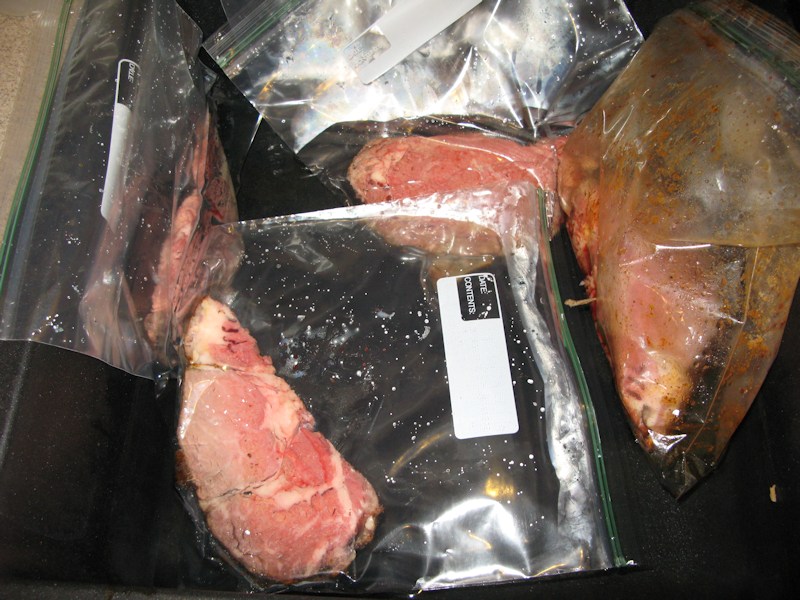
If you have any questions or comments about this page click
here to send email.
Last Modified:
December 24, 2022 03:21:05 PM
| 